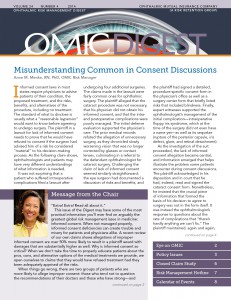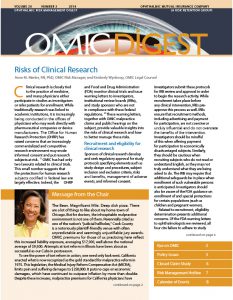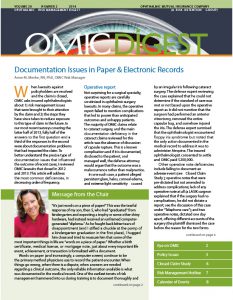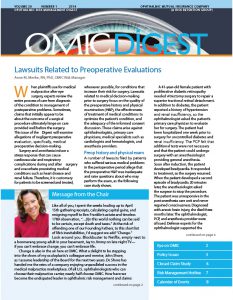PTK (Phototherapeutic Keratectomy)
SAVE THIS FORM TO YOUR COMPUTER BY USING THE DOWNLOAD BUTTON. PTK – Phototherapeutic Keratectomy
OMIC Digest Archives 2014
Improving the Accuracy of Electronic Health Records
Anne M. Menke, RN, PhD, OMIC Risk Manager
As the discussion of the two closed claims involving EHR in the lead article shows, records can become unreliable if steps are not taken to confirm the accuracy of the information. In a study that evaluated changes in the medical record of an ophthalmology practice when an EHR was adopted, the authors found that the length of the record increased due to copy-and-paste, copy-and-forward, and all-normal functionalities.1 They raised concerns that the increased volume of EHR records would make it difficult to distinguish the critical findings from the background data and adversely impact the eye surgeon’s ability to effectively diagnose and treat the patient. An editorial in Ophthalmology described the type of errors that EHRs can introduce, noting that they have created serious and unintended consequences that need to be identified and addressed immediately to ensure the integrity of the EHR.2 Risk reduction strategies from these articles and other sources are discussed here.
Q What principles should guide the use of EHR?
A A basic principle is to “document what you do and only what you do.”2 Experts stress the importance of unique documentation for each patient encounter and warn that functions such as carry forward can lead to documentation of findings that were not actually seen.1 This has implications for billing, as noted later.
Q Given the risk of erroneous documentation, may I use functions such as copy forward? If so, what are considered “best practices” for copying and pasting or carrying forward prior entries?
A Yes. Most articles reviewed for this issue of the Digest acknowledge the need for these tools, especially since adoption of EHRs has been shown, at least initially, to negatively impact the physician’s productivity and decrease the number of patients seen in a day. Some documentation guidelines make a very useful distinction between historical data that is unlikely to change (what I will call “stable data”) and information that is expected to change(what I will call “variable data”). Variable data can “only be presumed to be correct at the time the health care team member obtained it.”3 Examples include the chief complaint, review of systems, physical examination, assessment, and plan, all of which will usually be different for each encounter. One organization allows each physician to copy forward his/her own variable data elements, but requires in its EHR policy that the physician edit the data to make them current. Furthermore, the organization prohibits physicians from copying variable data from the note of another physician. Other groups ban any use of the copy-forward function for variable data. Stable data elements include allergies, historical procedures and surgeries, previous medical history, previous developmental history, immunizations, family history, previous social history, and prior reports (pathology, cytology, radiology, procedures, etc.). One institution allows all EHR “authors” to copy stable data elements from prior entries whether or not the current physician obtained the information. It does caution that reports that are not new should be labeled as copies and that current reports should be prominently displayed.
Q Are there other risks besides inaccuracy if information is copied and pasted?
A The authors of the editorial in Ophthalmology noted not only the possibility of documentation errors, but also the risk of billing fraud. Indeed, the Office of the Inspector General of Health and Human Services (HHS) warned that some providers may be using the technology to game the system. For example, notes from office visits in EHR tend to be much longer and more detailed. Some computer programs incorporate the additional data elements into their billing algorithm and may inadvertently code the visit as more comprehensive than it actually was, leading to possible allegations of false claims and billing fraud. In malpractice lawsuits, plaintiff attorneys have also questioned how a physician could have obtained all the information recorded in a visit note in such a short time. Concerned about such billing and documentation issues, one organization asked its software vendor to program the EHR so that all copied data must be reviewed and verified by clicking on a button. If the information is not pertinent to the current visit, the policy states that the physician should not carry it forward into the current record. Physicians who use EHR systems without such a review button can use the free-text feature to indicate in their note that they have confirmed the accuracy of the data that has been carried forward.
1. Sanders DS, Lattin DK, Read-Brown S, Tu DC, Wilson DJ, Hwang TS, Morrison JC, Yackel TH, Chiang MFl. “Electronic Health Record Systems in Ophthalmology: Impact on Clinical Documentation.” Ophthalmology. 2013;120(9):1745-1755.
2. Silverstone DE, Lim MC. “Ensuring Information Integrity in the Electronic Health Record: The Crisis and the Challenge.” Ophthalmology. 2014;121(2):435-436.
3. University of Illinois Medical Center at Chicago Documentation Guideline. Key Content Expert: David Sarne, MD, EMR Documentation Committee, http://chicago.medicine.uic.edu/compliance/comp_ppg/.
2014 Vol24 N2
http://www.omic.com/wp-content/uploads/2014/07/Digest-No-2-FINAL-7-14-14.pdf
Message from the Chair
 “It’s just words on a piece of paper!”
“It’s just words on a piece of paper!”
This was the tearful response of my son, then 5, who had “graduated” from kindergarten and expecting a trophy or some other shiny hardware, had instead received an unframed computer-generated “diploma.” As he fought back bitter tears of disappointment (and I stifled a chuckle at the pomp of a kindergarten graduation in the first place), I hugged him close and tried to reassure him that some of the most important things in life are “words on a piece of paper.” Whether a birth certificate, medical license, or mortgage note, just about every important life event, achievement, or transaction is formalized with a document.
Words on paper (and increasingly, a computer screen) continue to be the primary method physicians use to record the patient encounter. When things go wrong, when there is a dispute, when answers are needed regarding a clinical outcome, the only reliable information available is what was documented in the medical record. One of the earliest tenets of risk management hammered into us during training is to document thoroughly and maintain the integrity of the medical record. “If it’s not in the record, it wasn’t done,” is a familiar plaintiff attorney refrain.
Failure to document, lost charts, medication errors, illegible entries, and altered records are examples of documentation deficiencies that have torpedoedan otherwise defensible OMIC malpractice claim. The migration of medical documentation to the electronic record is the solution, we are told, to most of what ails the paper record. Perhaps, but not necessarily. On the plus side, lost charts, illegible handwriting, and record alteration should be a thing of the past. On the minus side, with the click of a mouse, one can copy, paste, and propagate redundant, repetitive, and sometimes inaccurate data. In this issue of the Digest, we explore the state of medical record documentation to better harness the good parts of the electronic platform while avoiding its pitfalls.
Speaking of words on paper, we are excited about a project OMIC has entered into with the AAO’s Hoskins Center for Quality Eye Care. We are translating each of the consent forms on the OMIC website into Spanish. This will make our internationally recognized library of ophthalmic consent forms available to a broader audience.
Our insureds spoke; we listened. While already permitting immediate sequential bilateral cataract extraction, OMIC has modified its underwriting requirements to allow immediate sequential bilateral intraocular refractive surgery. With appropriate guidelines and proper informed consent, insureds may now offer this option to patients seeking same-day bilateral refractive lens extraction.
Finally, every five years, our financial statements and overall corporate governance are reviewed by auditors from our domicile state of Vermont. I am happy to report that OMIC received the top rating on its internal financials and controls and was placed in the top compliance tier of the nation’s physician insurers. More good words on paper!
As for that tearful kindergartner, his college graduation was a few weeks ago. The setting may have been different, but many things were the same. There was pomp, circumstance, and more words on a piece of paper, and again some tears. This time, however, the tears were mine.
Tamara R. Fountain, MD, Chair of the Board










